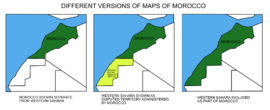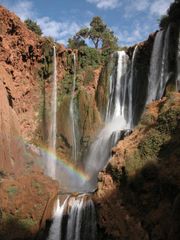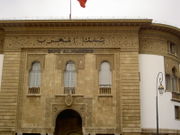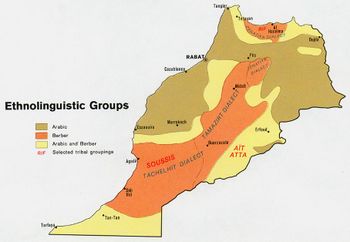Morocco
2007 Schools Wikipedia Selection. Related subjects: African Countries; Countries
| المملكة المغربية Al-Mamlaka al-Maghribiya Kingdom of Morocco |
|||||
|
|||||
| Motto: الله، الوطن، الملك (Arabic) "Allāh, al Waţan, al Malik" ( transliteration) "God, Country, King" |
|||||
| Anthem: Hymne Chérifien | |||||
|
The striped area on the map shows Western Sahara, most of which is de facto administered by Morocco as its " Southern Provinces". Its sovereignty, however, is currently in dispute (see footnote below and main article). |
|||||
| Capital | Rabat |
||||
|---|---|---|---|---|---|
| Largest city | Casablanca | ||||
| Official languages | Arabic (French, Amazigh, Moroccan Arabic widely spoken) |
||||
| Government | Constitutional monarchy | ||||
| - King | Mohammed VI | ||||
| - Prime Minister | Driss Jettou | ||||
| Independence | |||||
| - from France | March 2, 1956 | ||||
| - from Spain | April 7, 1956 | ||||
| Area | |||||
| - Total | 446,550 km² ( 57th) 172,414 sq mi |
||||
| - Water (%) | negligible | ||||
| Population | |||||
| - 2005 estimate | 33,241,259 ( 37th) | ||||
| - Density | 70/km² ( 122nd) 181/sq mi |
||||
| GDP ( PPP) | 2005 estimate | ||||
| - Total | $135.74 billion ( 54th) | ||||
| - Per capita | $4,503 ( 109th) | ||||
| HDI (2003) | 0.631 (medium) ( 124th) | ||||
| Currency | Moroccan dirham ( MAD) |
||||
| Time zone | UTC ( UTC+0) | ||||
| - Summer ( DST) | UTC ( UTC+0) | ||||
| Internet TLD | .ma | ||||
| Calling code | +212 | ||||
| All data excludes Western Sahara, much of which Morocco is in de facto military and administrative control (see " Southern Provinces"). The United Nations, however, holds that Western Sahara is a non- decolonized territory whose status awaits self-determination. Morocco has suggested an autonomous status for the territory. | |||||
The Kingdom of Morocco (Arabic: المملكة المغربية) is a country in North Africa. It has a long coastline on the Atlantic Ocean that reaches past the Strait of Gibraltar into the Mediterranean Sea. It borders Algeria to the east, the Mediterranean Sea and a relatively thin water border Spain to the north and the Atlantic Ocean to its west. There are also two Spanish exclaves bordering Morocco to the north. The border to the south is disputed. Morocco claims ownership of Western Sahara and has administered most of the territory since 1975.
Morocco, a constitutional monarchy, is the only African country that is not currently a member of the African Union. However, it is a member of the Arab League, Arab Maghreb Union, Organization of the Islamic Conference, Mediterranean Dialogue group, and Group of 77, and is a major non-NATO ally of the United States.
Name
The full Arabic name of the country (Al-Mamlaka al-Maghribiya) translates to The Western Kingdom. Al Maghrib (meaning The West) is commonly used. For historical references, historians used to refer to Morocco as Al Maghrib al Aqşá (The Furthest West), disambiguating it from the historical region called the Maghreb. The name Morocco in many other languages originates from the name of the former capital, Marrakech. The Berber/Amazigh word Murakush means Land of God.
History
Berber Morocco
The area of modern Morocco has been inhabited since Neolithic times, at least 8000 BCE, as attested by signs of the Capsian culture, in a time when the Maghreb was less arid than it is today. Many theorists believe the Berber language probably arrived at roughly the same time as agriculture (see Berber), and was adopted by the existing population as well as the immigrants that brought it. Modern genetic analyses have confirmed that various populations have contributed to the present-day population, including (in addition to the main Berber and Arab groups) Phoenicians, Sephardic Jews, and sub-Saharan Africans. The Berbers, often referred to in modern ethnic activist circles as "Amazigh," are more commonly known as "Berber" or by their regional ethnic identity, such as Chleuh. In the classical period, Morocco was known as Mauretania, although this should not be confused with the modern country of Mauritania.
Roman and sub-Roman Morocco
North Africa and Morocco were slowly drawn into the wider emerging Mediterranean world by Phoenician trading colonies and settlements in the late Classical period. The arrival of Phoenicians heralded a long engagement with the wider Mediterranean, as this strategic region formed part of the Roman Empire, as Mauretania Tingitana. In the fifth century, as the Roman Empire declined, the region fell to the Vandals, Visigoths, and then Byzantine Greeks in rapid succession. During this time, however, the high mountains of most of modern Morocco remained unsubdued, and stayed in the hands of their Berber inhabitants.
Early Islamic Morocco
By the seventh century, Arab expansion was at its greatest. In 670 AD, that the first Arab invasions of the North African coastal plain took place under Uqba ibn Nafi, a general serving under the Umayyads of Damascus. His army swept into what is now Morocco, which he called "Maghreb al Aqsa" or "The Far West", in the year 683. The Arab invasion of Morocco faced strong resistance from local Berbers. After about a century of fierce battles with Berbers, the Arabs occupied Morocco.
The Arab-Muslim Calipahtes (i.e. Umayyads of Damascus and the Abbasids of Baghdad) lost political influence over Morocco when the first Arab dynasty in the country, the Idrisid, cut ties with the Abbasid Caliphate in Baghdad and the Umayyad rule in Al-Andalus. After the reign of the Idrisids, Arabs lost political control within Morocco. After adopting Islam, several Berber dynasties formed their own Islamic dynasties and reigned over the country. This situation lasted until the Arab Saadi dynasty took over in the 16th century.
What became modern Morocco in the seventh century, was the area invaded by the Arabs, who brought their customs, culture, and Islam, to which most of the Berbers converted, forming states such as the Kingdom of Nekor. The country soon broke away from the control of the distant Abbasid caliphs in Baghdad under Idris ibn Abdallah who founded the Idrisid Dynasty. The Idrisids established Fez as their capital and Morocco became a centre of learning and a major regional power.
Morocco would reach its height under a series of Berber origin dynasties that would replace the Arab Idrisids. First the Almoravids, then the Almohads would see Morocco rule most of Northwest Africa, as well as large sections of Islamic Iberia, or Al-Andalus. Under Islamic rule, Spanish cities such as Sevilla and Granada were places where the citizenry prospered under a tolerant rule which also focused on scholarly advances in science, mathematics, astronomy, geography as well as medicine.
However, Islamic rule in the Iberian Peninsula ended with the fall of Granada to the forces of King Ferdinand and Queen Isabella. Under the Catholic Inquisition, troops pillaged Granada amongst other Islamic cities and persecuted its citizens, Muslims and Jewish. Rather than face persecution and possible execution, many Muslims and Jews fled to Morocco. The Inquisitors, eager to abolish any trace of Islamic culture, destroyed the libraries in Muslim Spain, where thousands of priceless texts were kept.
Smaller states of the region, such as the Berghouata and Banu Isam, were conquered. The empire collapsed, however, with a long running series of civil wars.
Morocco 1666-1912
The Alaouite Dynasty eventually gained control. Morocco was facing aggression from Spain and the Ottoman Empire that was sweeping westward. The Alaouites succeeded in stabilizing their position, and while the kingdom was smaller than previous ones in the region it remained quite wealthy. In 1684, they annexed Tangier.
Morocco was the first nation, in 1777, to recognize the fledgling United States as an independent nation. In the beginning of the American Revolution, American merchant ships were subject to attack by the Barbary Pirates while sailing the Atlantic ocean. At this time, American envoys tried to obtain protection from European powers, but to no avail. On December 20, 1777, Morocco's Sultan declared that the American merchant ships would be under the protection of the sultanate and could thus enjoy safe passage.
The Moroccan-American Treaty of Friendship stands as the U.S.'s oldest non-broken friendship treaty. Signed by John Adams and Thomas Jefferson, it has been in continuous effect since 1786. After the organization of the American government under the Constitution, President George Washington wrote a now venerated letter to the Sultan Sidi Mohamed strengthening the ties between the two countries. The United States legation (consulate) in Tangier is the first property the American government ever owned abroad. The building now houses the Tangier American Legation Museum.
European influence
Successful Portuguese efforts to control the Atlantic coast in the fifteenth century did not profoundly affect the Mediterranean heart of Morocco. After the Napoleonic Wars, Egypt and the North African maghreb became increasingly ungovernable from Istanbul, the resort of pirates under local beys, and as Europe industrialized, an increasingly prized potential for colonization. The Maghreb had far greater proven wealth than the unknown rest of Africa and a location of strategic importance affecting the exit from the Mediterranean. For the first time, Morocco became a state of some interest in itself to the European Powers. France showed a strong interest in Morocco as early as 1830. Recognition by the United Kingdom in 1904 of France's sphere of influence in Morocco provoked a German reaction; the crisis of June 1905 was resolved at the Algeciras Conference, Spain in 1906, which formalized France's "special position" and entrusted policing of Morocco to France and Spain jointly. A second Moroccan crisis provoked by Berlin, increased tensions between European powers. The Treaty of Fez (signed on March 30, 1912) made Morocco a protectorate of France. By the same treaty, Spain assumed the role of protecting power over the northern and southern Saharan zones on November 27 that year.
Many Moroccan soldiers ( Goumieres) who served in the French army assisted European and American troops in both World War I and World War II.
Resistance
Nationalist political parties, which subsequently arose under the French protectorate, based their arguments for Moroccan independence on such World War II declarations as the Atlantic Charter (a joint U.S.-British statement that set forth, among other things, the right of all people to choose the form of government under which they live). A manifesto of the Istiqlal Party (Independence party in English) in 1944 was one of the earliest public demands for independence. That party subsequently provided most of the leadership for the nationalist movement.
France's exile of Sultan Mohammed V in 1953 to Madagascar and his replacement by the unpopular Mohammed Ben Aarafa, whose reign was perceived as illegitimate, sparked active opposition to the French protectorate all over the country. The most notable occurred in Oujda where Moroccans attacked French and other European residents in the streets. Operations by the newly created "Armée de Libération", were launched on October 1, 1955. "L'Armée de Libération" was created by "Comité de Libération du Maghreb Arabe" (Arab Maghreb Liberation Committee) in Cairo, Egypt to constitute a resistance movement against occupation like the National Liberation Front in Algeria. Its goal was the return of King Mohammed V and the liberation of Algeria and Tunisia as well. France allowed Mohammed V to return in 1955, and the negotiations that led to Moroccan independence began the following year.
All those events helped increase the degree of solidarity between the people and the newly returned king. For this reason, the revolution that Morocco knew was called "la révolution du Roi et du Peuple" (The revolution of the King and the People) and it is celebrated every August 20.
Independence
Morocco recovered its political independence from France on March 2, 1956 and on April 7 France officially relinquished its protectorate. Through agreements with Spain in 1956 and 1958, Moroccan control over certain Spanish-ruled areas was restored, though attempts to claim other Spanish colonial possessions through military action were less successful. The internationalized city of Tangier was reintegrated with the signing of the Tangier Protocol on October 29, 1956 (see Tangier Crisis). Hassan II became King of Morocco on March 3, 1961. His rule would be marked by political unrest and the ruthless government response led by the Makhzen earned the period the name the "Years of Lead". The Spanish enclave of Ifni in the south became part of the new Morocco in 1969. Morocco annexed Western Sahara during the 1970s, but final resolution on the status of the territory remains unresolved. (See History of Western Sahara.)
Tentative political reform in the 1990s resulted in the establishment of a bicameral legislature in 1997. Morocco was granted Major non-NATO ally status in June 2004 and signed free trade agreements with the United States and the European Union.
In 2003, Morocco's largest city, Casablanca suffered from terrorist attacks. The attacks were targeted against Western and Jewish places and left 33 civilians dead and more than 100 people injured, mostly Moroccans.
In November 18 2006, Morocco celebrated the 51st anniversary of its independence.
Politics
Morocco is a de jure constitutional monarchy, with an elected parliament. The King of Morocco, with vast executive powers, can dissolve government and deploy the military, among other responsibilities. Opposition political parties are legal and several have arisen in recent years.
Human rights
Morocco's history after independence and under the reign of Hassan II was marked by the period of the so-called Years of Lead. Politically motivated persecutions and executions by the Makhzen were common.
However, under the reign of Mohammed VI, and with the launch of Equity and Reconciliation Commission (IER) to investigate into the atrocities, Morocco is trying to reconciliate with the victims. Many new laws and codes concerning all aspects of life are being launched. The most notable event was the creation of the Mudawana- a family code which was the first unique initiative of its kind in the Arab and Muslim world. The code gives women more rights. Other issues such as the abolition of capital punishment are being debated; the Moroccan parliament is due to vote on the issue in spring 2007.
Despite improvements under Mohammed VI, international organisations continue raising criticism against the human rights situation in Morocco in general (i.e. arrests of suspected Islamist extremists during 2004 and 2005 related to 2003 Casablanca bombings), and in Western Sahara in particular.
Administrative divisions
Morocco is divided into sixteen regions , and subdivided into sixty-two prefectures and provinces .
As part of a 1997 decentralization/regionalization law passed by the legislature, sixteen new regions were created. These regions are:
|
|
|
Western Sahara status
Due to the conflict over Western Sahara, the status of both regions of "Laâyoune-Boujdour-Sakia El Hamra" and "Oued Ed-Dahab-Lagouira" is disputed.
Morocco suggests, through the CORCAS, a self-governing and autonomy status to the whole territory of Western Sahara.
Geography
![Map showing the climate in and around Morocco [1]](../../images/91/9190.jpg)
At 172,402 sq.mi (446,550 sq.km), Morocco is the fifty-seventh largest country in the world (after Uzbekistan). It is comparable in size to Iraq, and is somewhat larger than the US state of California.
Algeria borders Morocco to the east and southeast though the border between the two countries has been closed since 1994. There are also four Spanish enclaves on the Mediterranean coast: Ceuta, Melilla, Peñón de Vélez de la Gomera, Peñón de Alhucemas, and the Chafarinas islands,as well as the disputed islet Perejil. Off the Atlantic coast the Canary Islands belong to Spain, whereas Madeira to the north is Portuguese. To the north, Morocco is bordered by and controls part of the Strait of Gibraltar, giving it power over the waterways in and out of the Mediterranean sea. The Rif mountains occupy the region bordering the Mediterranean from the north-west to the north-east. The Atlas Mountains run down the backbone of the country, from the south west to the north east. Most of the south east portion of the country is in the Sahara Desert and as such is generally sparsely populated and unproductive economically. Most of the population lives to the north of these mountains, while to the south is the desert. To the south, lies the Western Sahara, a former Spanish colony that was annexed by Morocco in 1975 (see Green March). Morocco claims that the Western Sahara is part of its territory and refers to that as its Southern Provinces.
Morocco's capital city is Rabat; its largest city is its main port, Casablanca.
Other cities include: Agadir • Essaouira • Fes • Marrakech • Meknes • Mohammadia • Oujda • Ouarzazat • Safi • Salè • Tangier • Tiznit • Tan-Tan
Climate
The climate is Mediterranean, which becomes more extreme towards the interior regions where it is mountainous. The terrain is such that the coastal plains are rich and accordingly, they comprise the backbone for agriculture. Forests cover about 12% of the land while arable land accounts for 18%. 5% is irrigated.
Economy
Morocco has signed Free Trade Agreements with the European Union (to take effect 2010) and the United States of America. The United States Senate approved by a vote of 85 to 13, on July 22, 2004, the US-Morocco Free Trade Agreement, which will allow for 98% of the two-way trade of consumer and industrial products to be without tariffs. The agreement entered into force in January 2006.
Morocco's largest industry is the mining of phosphates. Its second largest source of income is from nationals living abroad who transfer money to relatives living in Morocco. The country's third largest source of revenue is tourism.
Morocco ranks among the world’s largest producers and exporters of cannabis, and its cultivation and sale provide the economic base for much of the population of northern Morocco. The cannabis is typically processed into hashish. This activity represents 0.57 per cent of Morocco's Gross Domestic Product (GDP), estimated at US$ 37.3 billion. A UN survey estimated cannabis cultivation at about 1,340 square kilometres (515 sq mi) in Morocco's five northern provinces. This represents 10 % of the total area and 27 per cent of the arable lands of the surveyed territory and 1.5 per cent of Morocco's total arable land. Morocco is a party to the 1988 UN Drug Convention and in 1992 Morocco passed legislation designed to implement the Convention.
Morocco has an unemployment rate of 12.1% (2004 Data) and a 1999 estimate by the CIA puts 19% of the Moroccan population under the poverty line.
Though working towards change, Morocco historically has utilized child labor on a large scale. In 1999, the Moroccan Government stated that over 500,000 children under the age of 15 were in the labor force.
Demographics
Morocco is the fourth most populous Arab country, after Egypt, Sudan and Algeria. Most Moroccans are Sunni Muslims of Arab, Berber, or mixed Arab-Berber stock. About three-quarters of all present-day Moroccans are of Berber descent, while Arabs form the second largest ethnic group. The Arabs invaded Morocco in the seventh century and established their culture there. Morocco's Jewish minority has decreased significantly and numbers about 7,000 (see Jewish exodus from Arab lands). Most of the 100,000 foreign residents are French or Spanish; many are teachers or technicians and more and more retirees, especially in Marrakech.
There is no significant genetic difference between Moroccan Arabs and Moroccan non-Arabs (i.e. Berbers and Saharawis). Thus, it is likely that Arabization was mainly a cultural process without genetic replacement.. However, and according to the European Journal of Human Genetics, North-Western Africans were genetically closer to Iberians and to other Europeans than to sub-Saharan Africans..
Morocco's official language is classical Arabic. The country's distinctive Arabic dialect is called Moroccan Arabic. Approximately 12 million (40% of the population), mostly in rural areas, speak Berber – which exists in Morocco in three different dialects ( Tarifit, Tashelhiyt, and Tamazight) – either as a first language or bilingually with the spoken Arabic dialect. French, which remains Morocco's unofficial second language, is taught universally and still serves as Morocco's primary language of commerce and economics. It also is widely used in education and government. About 20,000 Moroccans in the northern part of the country speak Spanish as a second language in parallel with Tarifit. English, while still far behind French and Spanish in terms of number of speakers, is rapidly becoming the foreign language of choice among educated youth. As a result of national education reforms entering into force in late 2002, English will be taught in all public schools from the fourth year on.
Most people live west of the Atlas Mountains, a range that insulates the country from the Sahara Desert. Casablanca is the centre of commerce and industry and the leading port; Rabat is the seat of government; Tangier is the gateway to Morocco from Spain and also a major port; Fez is the cultural and religious centre; and the dominantly "Berber" Marrakech is a major tourist centre.
Education in Morocco is free and compulsory through primary school (age 15). Nevertheless, many children – particularly girls in rural areas – still do not attend school. The country's illiteracy rate has been stuck at around 50% for some years, but reaches as high as 90% among girls in rural regions. On September 2006, UNESCO awarded Morocco amongst other countries; Cuba, Pakistan, Rajastan (India) and Turkey the "UNESCO 2006 Literacy Prize".
Morocco has about 230,000 students enrolled in fourteen public universities. The Mohammed V University in Rabat and Al Akhawayn University in Ifrane (a private university) are highly regarded. Al-Akhawayn, founded in 1993 by King Hassan II and King Fahd of Saudi Arabia, is an English-language American-style university comprising about 1,000 students. The University of Al Karaouine, in Fes, is considered the oldest university in the world and has been a centre of knowledge for more than 1,000 years.
International rankings
- The 2002 Reporters Without Borders' worldwide press freedom index ranked Morocco 119th out of 167 countries.
- The Economist''s worldwide quality-of-life index 2005 ranked Morocco 65th out of 111 countries.
Affliations
| Organization | Dates | |
|---|---|---|
| United Nations | since November 12, 1956 | |
| Arab League | since October 1, 1958 | |
| International Olympic Committee | since 1959 | |
| Organization of African Unity | co-founder May 25, 1963; withdrew November 12, 1984 | |
| |
Group of 77 | since June 15, 1964 |
| Organization of the Islamic Conference | since September 22, 1969 | |
| Arab Maghreb Union | since February 17, 1989 | |
| |
World Trade Organization | since January 1, 1995 |
| Mediterranean Dialogue group | since February 1995 | |
| Major non-NATO ally | since January 19, 2004 | |
Bilateral and multilateral agreements
- Agadir Agreement
- Middle East Free Trade Area
- General Agreement on Tariffs and Trade
- Euro-Mediterranean free trade area
- US-Morocco Free Trade Agreement







